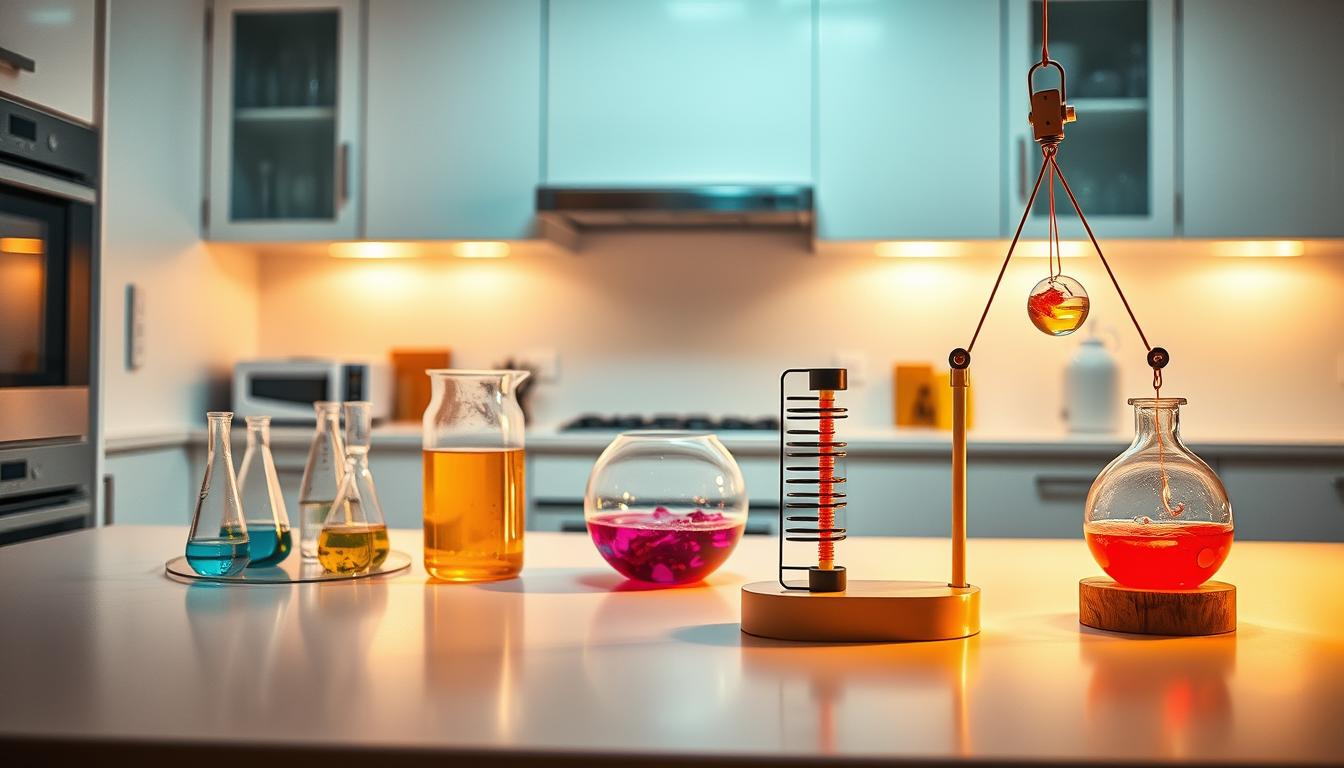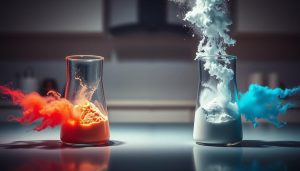A single cup of whipped topping contains over 4 million microscopic air pockets – each one locked in place by delicate chemical bonds. This everyday transformation from liquid to cloud-like foam demonstrates fundamental scientific principles at work in your home.
When you aerate dairy products, you’re engineering edible structures through precise physical changes. Fat molecules rearrange themselves into intricate networks while water and air create stable suspensions. These reactions mirror industrial processes used in food manufacturing, scaled down for your countertop.
This guide reveals how temperature control, tool selection, and timing influence molecular interactions during foam creation. You’ll discover why cold bowls matter more than wrist strength and how electric mixers affect bubble formation differently than manual whisks.
Key Takeaways
- Fat molecules form protective layers around air pockets during aeration
- Colloidal systems determine foam stability and texture
- Temperature controls crystallization of milk fats
- Mechanical energy input affects bubble size distribution
- Kitchen tools influence chemical bonding efficiency
- Phase transitions create permanent structural changes
Introduction: Embracing Culinary Chemistry
Your kitchen becomes a laboratory when working with everyday ingredients. Dairy-based foams like whipped topping reveal how basic physics shapes textures we love. The magic happens when simple components rearrange at microscopic levels through controlled energy input.

Overview of Whipped Cream
Heavy cream’s high fat content – typically 30-36% – makes it ideal for aeration. These fats exist as microscopic spheres suspended in liquid. When agitated, their protective membranes break, releasing sticky proteins that cling to air bubbles.
Fresh dairy works best because processing affects fat structure. Ultra-pasteurized versions often require stabilizers since heat treatment weakens natural binding properties. Cold temperatures keep fats firm, helping them hold shape during mixing.
The Role of Fat and Air in Transformation
Mechanical whipping forces air into the liquid while shearing fat globules. Each bubble gets coated with fragmented fats that prevent collapse. This creates a stable network where air constitutes up to 50% of the final volume.
| Factor | Impact on Foam | Ideal Conditions |
|---|---|---|
| Fat Content | Determines stiffness | 30% minimum |
| Temperature | Affects molecular bonds | 4-7°C (39-45°F) |
| Agitation Speed | Controls bubble size | Medium-high setting |
Timing proves critical. Under-whip, and the foam collapses. Overdo it, and fats clump into butter. Precision turns a liquid into edible architecture – proof that cooking mirrors chemical engineering.
Understanding the Science Behind Cream Whipping
Creating fluffy textures relies on hidden interactions between everyday ingredients. At the heart of this process lies a unique type of mixture called a colloid – the secret behind dairy’s ability to hold air.

What Is a Colloid and Why It Matters
Cream acts as a liquid-based colloid where solid fat particles float in milk. These microscopic droplets stay evenly spread without dissolving, forming a stable suspension. When energy gets added through mixing, this balance shifts dramatically.
The fat globules’ protective membranes break during agitation. Released fats then cluster around trapped air pockets. This three-way dance between solids, liquids, and gases creates edible architecture.
How Air Bubbles Create a Stable Emulsion
Mechanical mixing forces gas into the liquid, forming countless air bubbles. Each sphere gets coated with sticky fat particles that prevent collapse. The result? A foam where gas makes up half the volume.
| Colloid Component | Role in Stability | Key Function |
|---|---|---|
| Fat Droplets | Form protective shells | Prevent bubble merging |
| Liquid Milk | Maintains fluidity | Allows even distribution |
| Air Bubbles | Create texture | Provide volume increase |
Timing determines success. Stop too soon, and the structure remains weak. Mix too long, and fats clump irreversibly. Mastering this balance transforms simple ingredients into scientific marvels.
Essential Ingredients and Tools for Success
Successful foam creation starts with precise ingredient selection and purpose-built tools. Like building a house requires quality materials, crafting stable dairy foam demands specific components that work in molecular harmony.

Choosing the Right Cream with High Fat Content
Your foundation begins with cream containing at least 30% fat. Lower percentages create weak structures as stretched fat globules fail to trap air effectively. Heavy options (35-40% fat) form stiffer peaks due to denser molecular networks.
Temperature matters as much as composition. Cold cream keeps fat molecules firm during agitation, preventing premature melting. Always chill ingredients below 45°F before starting – this maintains structural integrity from first whip to final dollop.
Must-Have Kitchen Equipment
Metal bowls outperform other materials by conducting cold efficiently. Pair them with either a wire whisk for manual control or an electric mixer for rapid aeration. For experimental approaches, try a mason jar – vigorous shaking can yield similar results through kinetic energy.
| Tool | Best For | Time Required |
|---|---|---|
| Electric Mixer | Quick results | 2-4 minutes |
| Hand Whisk | Precision control | 6-8 minutes |
| Mason Jar | Portable method | 5-7 minutes |
Flavor enhancers like powdered sugar blend seamlessly without disrupting fat networks. Add them gradually during mixing – their fine particles dissolve completely, maintaining smooth texture while sweetening your creation.
Step-by-Step Guide to Whipping Cream at Home
Transform ordinary ingredients into cloud-like foam using basic kitchen tools. This hands-on activity demonstrates how simple motions create complex structures through food science principles.

Preparation and Accurate Measurements
Start with chilled ingredients – cold cream maintains fat structure better than room-temperature versions. Use measuring spoons for additives like powdered sugar. Precision matters: too much sugar weakens air pockets, while too little reduces stability.
“Successful foam formation begins before you start shaking or mixing – proper preparation determines 80% of outcomes.”
Shaking vs. Whisking: Techniques That Work
The mason jar method offers portable experimentation. After adding ingredients:
- Shake vigorously for 90 seconds
- Check consistency every 30 seconds
- Stop when silence replaces liquid sounds
Traditional methods use mechanical energy differently:
| Method | Time Required | Equipment |
|---|---|---|
| Jar Shaking | 1-3 minutes | Sealed container |
| Mechanical Whisking | 2-5 minutes | Mixer/whisk |
Watch for visual cues during both processes. Soft peaks form when lifting tools leaves temporary indentations. Firm peaks hold their shape completely – this stage works best for dessert toppings.
Whipping Cream Into Science: Tips for Perfect Results
Achieving the perfect texture requires understanding physical changes at microscopic levels. When making dairy foam, time management proves as crucial as technique. The process involves balancing air incorporation with fat stabilization – a delicate dance of physics and chemistry.

Mastering the Timing and Intensity
Your first 45 seconds determine success. Stopping too early lets bubbles collapse, reversing progress. Consistent motion matters more than speed – gentle shaking often outperforms frantic whisking. Listen for the telltale silence signaling proper air integration.
| Stage | Time Range | Visual Cue |
|---|---|---|
| Under-Whipped | 0-45 seconds | Liquid sloshes freely |
| Ideal Texture | 2-3 minutes | Soft peaks hold shape |
| Over-Processed | 4+ minutes | Grainy appearance |
Avoiding Common Pitfalls
Warm ingredients sabotage results by melting fat droplets prematurely. Use chilled tools and avoid direct hand contact. For stable structures, maintain steady rhythm rather than alternating speeds. Recognize the molecular gastronomy principles governing each phase transition.
Over-whipping remains the top error. Once fats cluster irreversibly, you’ll create butter instead of foam. Track progress visually – glossy surfaces indicate readiness, while dull textures warn of impending collapse. With practice, you’ll instinctively sense the perfect stopping point.
Exploring Variations and Experiment Extensions
Your dessert experiments can unlock surprising transformations using the same core ingredients. By adjusting ratios and techniques, you’ll witness how basic components shift between states through applied physics.
Experimenting with Additional Flavors
Try mixing cocoa powder into chilled cream before whipping. The fine particles disperse evenly without disrupting the fat network. You’ll create chocolate-flavored foam with identical stability to plain versions.
Other additives work similarly:
- Fruit purees add tanginess while maintaining structure
- Vanilla extract enhances aroma without thinning texture
- Citrus zest introduces brightness through oil-based flavors
These variations prove the air-trapping matrix adapts to new elements when introduced properly. Always add extras gradually during early mixing stages for best integration.
Transitioning from Whipped Cream to Butter
Continue agitating past the stiff peak stage, and watch magic happen. The fat clusters tighten further, forcing out liquid buttermilk. What remains transforms into spreadable butter through pure mechanical action.
| Stage | Time Required | Key Change |
|---|---|---|
| Soft Peaks | 2-3 minutes | Air fully incorporated |
| Stiff Peaks | 4-5 minutes | Fat network stabilizes |
| Butter Formation | 8-10 minutes | Liquid separates |
This progression demonstrates how energy application alters dairy’s physical state. Rinse the solid mass under cold water to remove excess moisture, then shape your homemade butter. The process turns kitchen tools into molecular manipulation devices.
Health, Sustainability, and Safety Considerations
Your dessert choices impact both personal wellness and environmental health. Understanding these connections helps you make informed decisions about ingredients and methods.
Nutritional Insights and Fat Content Benefits
High-fat dairy forms stable foams but adds calories. The membranes around milk fats trap air efficiently, though moderation remains key. Homemade versions let you adjust sweetness and portion sizes for balanced enjoyment.
Understanding Nitrous Oxide and Environmental Impact
Commercial aerosol products use pressurized gas to create instant foam. While nitrous oxide emissions from whipped cream cans are minimal, its 300x heat-trapping power versus CO2 raises ecological concerns. Recreational misuse through balloons poses separate health risks.
Prioritize stainless steel dispensers or manual methods to reduce reliance on single-use canisters. This approach cuts waste while maintaining control over fat content – proving culinary science can align with sustainability goals.



